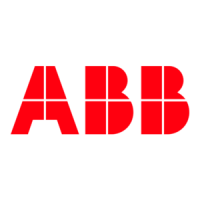Advant
®
Controller 450 User’s Guide
Table of Contents
3BSE 002 415R701 Rev A xi
ILLUSTRATIONS
Figure 1-1. Example of Advanced Control System with Advant Controller 450........... 1-1
Figure 1-2. Basic Documentation Structure.................................................................... 1-2
Figure 1-3. Cabinet for Advant Controller 400 Series, RM500, in a Front View......... 1-16
Figure 1-4. Advant Controller 450 in RM500 Cabinet (doors opened) -
Example of Physical Appearance............................................................... 1-17
Figure 1-5. Example of PC Element (AND, TON, SHIFT).......................................... 1-18
Figure 1-6. Example of Version Designation with Compatibility Codes for
Basic Software............................................................................................ 1-19
Figure 1-7. Example of Advant Controller 450 Hardware Configuration incl.
a Variant of Process I/O.............................................................................. 1-21
Figure 1-8. Advant Controller 450 Block Diagram ...................................................... 1-22
Figure 1-9. Advant Controller 450 Functional Interfaces............................................. 1-23
Figure 1-10. Location of System Program Card (PCMCIA) .......................................... 1-25
Figure 1-11. Location of Additional Program Cards ...................................................... 1-26
Figure 1-12. Principle of Power Supply of an Advant Controller 450
(a.c. mains supply)...................................................................................... 1-38
Figure 1-13. Principle of Redundant Power Supply of an Advant Controller 450
(a.c. mains supply)...................................................................................... 1-39
Figure 1-14. Voltage Regulation in Controller Subrack.................................................. 1-42
Figure 1-15. Voltage Regulation in I/O Subrack............................................................. 1-43
Figure 1-16. Input and Output Signal Paths (in principle).............................................. 1-47
Figure 1-17. Input and Output Signal Paths (in principle).............................................. 1-48
Figure 1-18. Example of Connection Unit for S100 I/O................................................. 1-49
Figure 1-19. Application of Object Oriented Connection of S100 I/O........................... 1-50
Figure 1-20. Principle of HART Implementation ........................................................... 1-52
Figure 1-21. Principle of HART implementation using S800 I/O .................................. 1-53
Figure 1-22. Digital Input Signal, Block Diagram.......................................................... 1-56
Figure 1-23. Digital Output Signal, Block Diagram....................................................... 1-58
Figure 1-24. Analog Input Signal, Block Diagram......................................................... 1-62
Figure 1-25. Analog Input/Output Signal with Redundancy, Block Diagram................ 1-62
Figure 1-26. Analog Output Signal, Block Diagram ...................................................... 1-65
Figure 1-27. Pulse Counter Input Signal DSDP 110, Block Diagram ............................ 1-66
Figure 1-28. Pulse Counter Input Signal DSDP 150, Block Diagram............................ 1-66
Figure 1-29. Example of basic I/O Unit, DSDX 452 - 20 Inputs and 12 Outputs .......... 1-68
Figure 1-30. S800 I/O. Field Communication Interface with an I/O module on a
Compact or Extended MTU. ...................................................................... 1-70
Figure 1-31. Example of Electrical Redundant Bus Extension....................................... 1-81
Figure 1-32. Example including Non-redundant Optical Bus Extension........................ 1-82
Figure 1-33. Example of Physical Configuration of Non-redundant MasterFieldbus

